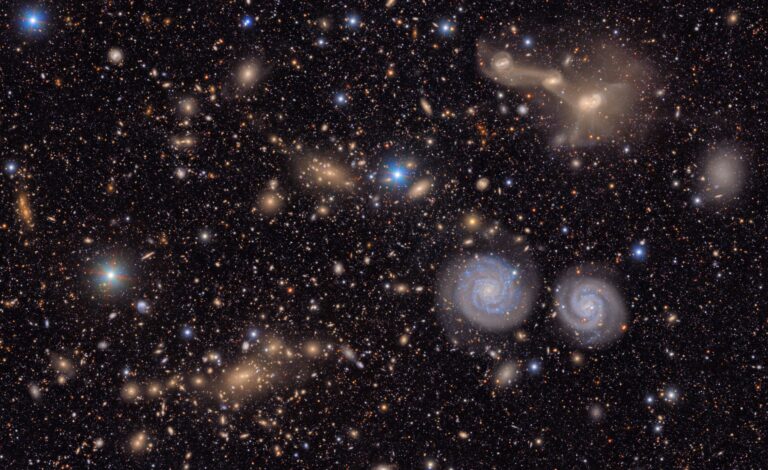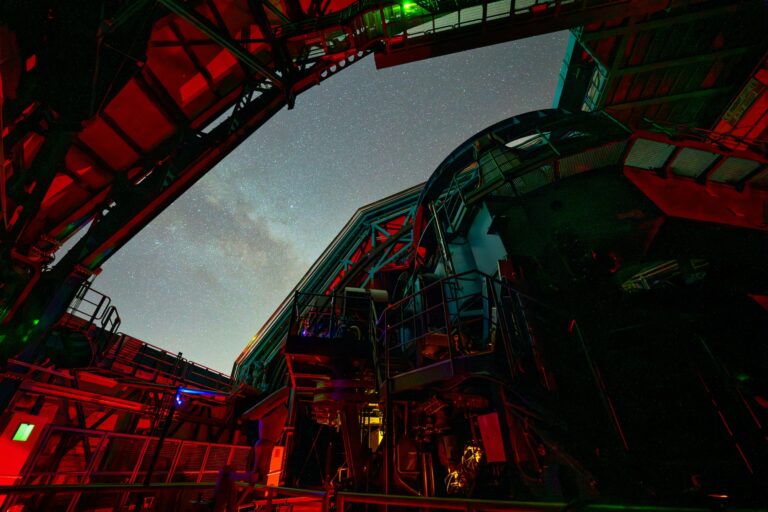
When the James Webb Space Telescope (JWST) captured its first images in 2022, the scientific community was in awe by the abundance of unprecedented cosmic findings. Now it is peering far back into the early universe and bringing forth new insights into distant, massive galaxies.
A recent study led by Elena Asencio, a University of Bonn Ph.D. student, has developed a fresh take about two extremely large galaxy clusters on the fast-track of a collision. The two clusters combine to make an even larger galaxy cluster, called El Gordo (Spanish for “the fat man”), which was discovered a mere 11 years ago by astronomers using NASA’s Chandra X-ray Observatory.
El Gordo, catalogued as ACT-CL J0102-4915, lies about 7.3 billion light-years from Earth. In recent years astronomers have used El Gordo to reveal plenty of fresh science by unveiling cosmic objects through gravitational lensing, an effect whereby an object’s gravity distorts or magnifies background objects. And El Gordo is now providing fresh intuition into models of cosmology.
El Gordo on a diet
The galaxy cluster is aptly named after its behemoth mass — it weighs in at about 2.1 quadrillion solar masses (try writing 2 with 15 zeros after to see just how large that number is!). Earlier estimations of El Gordo’s mass have typically been even greater and with higher uncertainties. The same team that produced this year’s study published a previous paper claiming El Gordo’s new, lesser weight.
If there’s a massive enough object, then fortunately, along comes gravitational lensing. The distorted galaxies in El Gordo’s background emit deflected light, which the team used to their advantage. The 2023 study offers an exciting mass uncertainty of 10 percent (within a fixed radius), meaning the precision is now much higher than before.
However, because the updated estimates of mass are lower, some scientists are skeptical — despite the fact that the recent mass was derived from Hubble Space Telescope observations and agrees with other results using different methods and JWST data. And with JWST data, El Gordo is now disproving an even bigger idea that may cause a strong shift in the astronomical world.
Simulations questioning concordance
When astronomers analyzed recent El Gordo data, they were shocked to find that its mass and evolution seemed advanced for its age under the standard theory of cosmology: the LCDM (Lambda-cold dark matter) model, or the concordance model. In a nutshell, this model suggests a certain order of object formation and requires the agreement of regular matter, cold dark matter, and dark energy. But in this case, the cluster is moving at a much higher speed than astronomers would expect, when the universe was only around half its present age.
Asencio’s team used a simulation of interactions of the cluster’s galaxies in order to derive the results in their study, including getting an estimate of the collision speeds of the galaxies within the cluster. Their “first” simulation required many details to strictly fit the LCDM model, and this time the team attempted the simulation but with less detailed LCDM constraints. Essentially, this allows the international team to count how many simulated cluster pairs match what would be seen in El Gordo before colliding.
The tricky part of these findings is that the new mass “does reduce the tension with LCDM,” said Asencio in a press release, but the simulation shows that the tension is extreme and “highly significant for any plausible collision velocity.” To fit the LCDM model, the collision speed needs to be much slower, which disagrees with what El Gordo shows.
LCDM is on rocky ground
If the team’s simulation implements a faster collision speed, it is possible to recreate the galaxy cluster as it now appears, but this this is nearly impossible within LCDM. Asencio’s team is on an excellent path to examine El Gordo’s advanced age in greater detail and to influence other scientists to do the same. Everything about El Gordo puts the standard model in question, and it’s not the only one. Thanks to both JWST and HST (mostly JWST), they have studied other LCDM-defying objects. Indranil Banik of the School of Physics and Astronomy at St. Andrews, who developed the statistical analysis used in the new study, mentioned in a press release that when the Bullet Cluster is “taken in combination with El Gordo, the situation becomes even worse for LCDM.” This major scientific model acting as the backbone of cosmology might be reaching questionable days and might have to make some room for a newer model.









